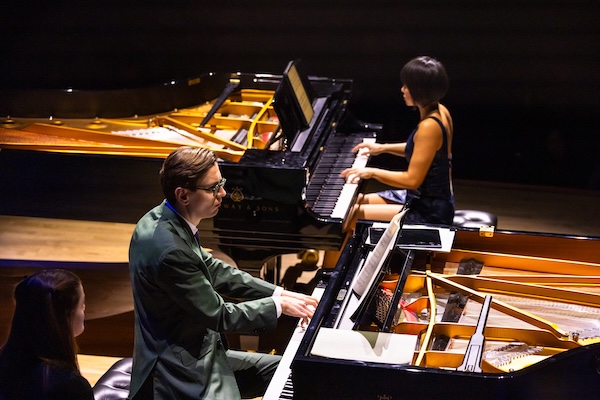Concert Review: Vikingur Ólafsson and Yuja Wang — Opposites Attract
By Aaron Keebaugh
Playing side-by-side on two different pianos facing in opposite directions on the Symphony Hall stage, Vikingur Ólafsson and Yuja Wang were as complementary, in a flavorsome way, as lemon and chocolate.

Yuja Wang and Vikingur Ólafsson at Boston’s Symphony Hall. Photo: Robert Torres
One pianist is known for being pensive and reserved, the other for seismic dynamism.
But when paired together, as they were in their Celebrity Series recital last weekend, Vikingur Ólafsson and Yuja Wang bring out each other’s hidden qualities.
Playing side-by-side on two different pianos facing in opposite directions on the Symphony Hall stage, Ólafsson and Wang were as complementary, in a flavorsome way, as lemon and chocolate. Interpretive flair was matched by earthy power. And given these polar extremes, there were plenty of fireworks as well.
Their varied program — an assortment of works by Berio, Nancarrow, Cage, Pärt, Adams, Schubert, and Rachmaninoff — invited thoughtfulness and sensitivity. Yet these pianists never shied away from turning up the heat when the music called for it.
The duo played John Adams’s Hallelujah Junction with devil-may-care freedom, like speeding down a deserted highway in a top-down convertible. Everything moved with wild abandon as Ólafsson and Wang traded each overlapping musical shout of joy. Of the two, Wang delivered the most power, her heavy chords, sounded during mid-score, conveyed, quite literally, head-banging intensity. All the while, Ólafsson maintained a stalwart sonic presence, keeping an eye as the gradual build up was kicked up a notch to exuberance.
Likewise, Rachmaninoff’s Symphonic Dances, heard via the composer’s two-piano arrangement, came off as arrestingly frantic. Wang and Ólafsson played the outer movements at a breakneck pace that never wanted for clarity. The opening gestures and hammered chords in the finale stung the ear in a way that Rachmaninoff’s music never quite achieves when taken at broader tempos.

Yuja Wang and Vikingur Ólafsson at Boston’s Symphony Hall. Photo: Robert Torres
The quicksilver jolting was challenging but rewarding, the musical contrasts seesawing back and forth with dramatic urgency. The central Waltz mesmerized as the duo made the music feel as warm and familiar as a family antique. Yet even here, they played with a beguiling sense of freedom, making sure that sudden shifts in texture and dynamics kept listeners ears on their toes.
That yin-yang approach achieved the same effect in Schubert’s Fantasie in F minor, Op. 40. But here, the pianists showcased as much tenderness as they did stormy tension. Wang’s line softly and gracefully served the opening theme. Ólafsson, who supplied the inner voices, was statelier and declarative.
They worked together by gradually leaning into the music’s intensity. Ólafsson’s figures generated steadiness and resolve, which gave Wang the opportunity to ride on the crest of the musical wave. Her skittering trills and cascading octaves inevitably supplied palpable force.
But, by working in tandem, Ólafsson and Wang knew precisely when to pull the music back just enough to never fall into emotional extremes. Pauses between sections managed to generate nuanced tension. Other parts, like the fugue, coursed with concentrated fervor. Ólafsson approached the various textures with his usual sense of proportion. Wang’s interpretation ranged from welcoming subtlety to leaning into furious eruptions of passion. This complementary effort made Schubert sound compellingly vibrant.
A series of shorter works embraced the duo’s playful and delicate sides. The mock boogie-woogie rhythms of the sixth of Conlon Nancarrow’s “Studies for Player Piano” bounced along wit childlike gaiety. Ólafsson’s resonant chords and Wang’s pristine melodies in Luciano Berio’s Wasserklavier No. 3 fell as gentle as raindrops. Rippling figures and sudden pauses also buoyed a perception of eerie stasis in John Cage’s Experiences for two pianos. And the simplicity of Arvo Pärt’s Hymn to a Great City was powerfully direct.
Four encores continued in the same groove, exploring combinations of tenderness and flamboyance. But even here, Dvorak’s Slavonic Dance, Op. 72, No. 2, Schubert’s March Militaire, and Brahms’s Waltzes from Op. 39 and Hungarian Dance No. 1 were filled with the surprises that come when opposites pull on each other. As English poet William Blake recognized, “Without contraries is no progression.”
Aaron Keebaugh has been a classical music critic in Boston since 2012. His work has been featured in the Musical Times, Corymbus, Boston Classical Review, Early Music America, and BBC Radio 3. A musicologist, he teaches at North Shore Community College in both Danvers and Lynn.
